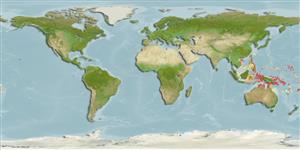>
Gobiiformes (Gobies) >
Gobiidae (Gobies) > Gobiinae
Etymology: Trimma: Greek, trimma, -atos = something crushed (Ref. 45335); pajama: Name from the Hindi word 'pajama', a loose clothing worn when retiring for the night, alluding to the contrasting stripes so common in at least the British version of that garment; noun in apposition.
Environment: milieu / climate zone / depth range / distribution range
Ecologia
marinhas associadas(os) a recifes; intervalo de profundidade 3 - 10 m (Ref. 96671). Tropical
Western Pacific: Indonesia and Papua New Guinea, with photographs and specimens from the Solomon Is. and Palau (Ref. 96671); and Tonga (Ref. 90102).
Tamanho / Peso / Idade
Maturity: Lm ? range ? - ? cm
Max length : 1.6 cm SL (female)
Descrição suscinta
Chaves de identificação | Morfologia | Morfometria
Espinhos dorsais (total) : 7; Raios dorsais (total) : 8; Espinhos anais: 1; Raios anais : 8. This species is distinguished by the following characters: predorsal midline with 6 scales; 2 ctenoid scales along the upper border of the opercle; cheek scaleless; first 2 dorsal spines slightly elongated and reaching posteriorly to between the base of the spine and the base of the first ray of the second dorsal fin; unbranched pectoral-fin rays; a fifth pelvic fin ray which branches once dichotomously and is 58-72% the length of the fourth ray; full basal membrane connecting the inner margins of the fifth pelvic fins rays in undamaged specimens; live colour pattern of red-orange and dark brown or grey stripes on the body reaching posteriorly to the anterior half of the caudal peduncle, it is unique among members of the genus, as is the preserved colour pattern of dark and light body stripes (Ref. 96671).
This species appears to be restricted to relatively shallow (3-10 m) reef areas protected from wave
exposure. Type specimens were collected exclusively from within beds of Halimeda macroalgae growing beneath branching Acropora coral stands. It is apparently the only species of the genus to be limited to this habitat (Ref. 96671).
Ciclo de vida ou comportamento de acasalamento
Maturidade | Reprodução | Desova | Ovos | Fecundidade | Larvas
Winterbottom, R., M.V. Erdmann and N.K.D. Cahyani, 2014. Three new species of Trimma (Pisces; Gobioidei) from Indonesia. Zootaxa 3838(3):367-384. (Ref. 96671)
Status na Lista Vermelha da UICN (Ref. 130435: Version 2024-2)
Ameaça para os humanos
Harmless
Uso pelos humanos
Pescarias: sem interesse
Ferramentas
Relatórios especiais
Baixar XML
Fontes da internet
Estimates based on models
Preferred temperature (Ref.
123201): 27.5 - 29.4, mean 28.8 °C (based on 999 cells).
Índice de diversidade filogenética (Ref.
82804): PD
50 = 0.5000 [Uniqueness, from 0.5 = low to 2.0 = high].
Bayesian length-weight: a=0.01023 (0.00477 - 0.02194), b=3.01 (2.83 - 3.19), in cm total length, based on LWR estimates for this (Sub)family-body shape (Ref.
93245).
Resiliência (Ref.
120179): Elevada, tempo mínimo de duplicação da população menor que 15 meses (Preliminary K or Fecundity.).
Fishing Vulnerability (Ref.
59153): Low vulnerability (10 of 100).
